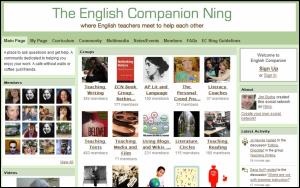A couple months ago I mentioned the English Companion Ning. That group is now nearing 10,000 members, and I encourage you more than ever to get involved!
For those of you who don’t know much about Nings, here’s a quick Q and A from member Jennifer Ansbach.
What’s a Ning?
A ning is a closed social network, like a Myspace or Facebook with a restricted membership. You have a profile, a blog, and participate in forums and send/receive messages.
What is the English Companion Ning?
Started one year ago this week by English teaching guru Jim Burke, the English Companion Ning is a place to share resources, ask questions, and participate in online, self-directed professional development.
Why should I join?
Jim Burke has leveraged his author and professional connections to bring some of the leaders in English education to the ning. Members include not only Jim Burke but current NCTE president and author Carol Jago, outgoing NCTE president and author Kylene Beers, and others who publish about best practices. Each month there is a professional book club, with an online discussion led by the author. Past books included Kelly Gallagher’s Readicide and Tom Newkirk’s Holding on to Good Ideas in Times of Bad Ones. This month’s book club on improving student writing features Penny Kittle’s Write Beside Them.
There are forums devoted to specific topics, with people posting their handouts, lesson plans, and strategies. In addition, there is a place to seek help for questions or for support. Yesterday someone asked what to do when your urban students admit they think you are a pushover. Within a few hours, several people had offered solid advice and resources. Earlier this year, a teacher posted about celebrating with his student teacher, putting her in her car, and having a truck kill her instantly around the corner. That teacher found a place to share his grief and also received help and ideas for putting together a fitting tribute to the young woman (his students had written letters to her that he hadn’t given to her–he crafted a eulogy of the students’ own words about what she meant to them).
It’s free to join. Just sign up on englishcompanion.ning.com. Jim Burke pays the $25 a month to keep it running and does not accept any advertising on the site. I am not a paid promoter. This week, as the ECNing celebrates its first birthday, it has 9,700 members and Jim is hoping to reach 10,000 this week. He asked us to make sure our colleagues are aware of the ning and what it has to offer.
Thanks, Jennifer! Well articulated. This ning is perfect for those of us engaged in the sometimes lonely business of teaching Reading and Language Arts!


